The Queen - Movie Review
 The Queen 2006
The Queen 2006 As the cries for “God Save Dame Helen Mirren” begin to waft across the shores, we have to join in the chorus. Not that we are new fans. We first took notice of the fearless young actress when she appeared in the famed Peter Hall production of “A Midsummer Night’s Dream” that seemed to epitomize the best of the late 1960s theatre. It didn’t hurt that she got to play along with such talented folks as Diana Rigg and David Warner. For the past four decades she has managed to slide under the radar of most filmgoers with her perfectly detailed, often powerful, and sometimes just plain brilliant portrayals which have garnered her numerous accolades including two Oscar nominations for Best Supporting Actress.
As the cries for “God Save Dame Helen Mirren” begin to waft across the shores, we have to join in the chorus. Not that we are new fans. We first took notice of the fearless young actress when she appeared in the famed Peter Hall production of “A Midsummer Night’s Dream” that seemed to epitomize the best of the late 1960s theatre. It didn’t hurt that she got to play along with such talented folks as Diana Rigg and David Warner. For the past four decades she has managed to slide under the radar of most filmgoers with her perfectly detailed, often powerful, and sometimes just plain brilliant portrayals which have garnered her numerous accolades including two Oscar nominations for Best Supporting Actress.
 The first was for her sharp portrayal of the fertile and bedeviled Queen Charlotte in “The Madness of King George”, who attempted to deal with her husband King George III’s mental deterioration while juggling her position as Queen and mother to fifteen children. Her second nomination was for her exquisitely etched den mother to all the downstairs help in Robert Altman’s majestic mystery play “Gosford Park”.
The first was for her sharp portrayal of the fertile and bedeviled Queen Charlotte in “The Madness of King George”, who attempted to deal with her husband King George III’s mental deterioration while juggling her position as Queen and mother to fifteen children. Her second nomination was for her exquisitely etched den mother to all the downstairs help in Robert Altman’s majestic mystery play “Gosford Park”.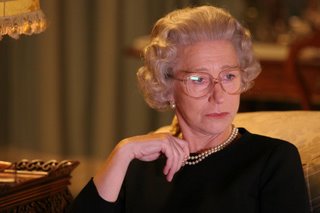 And now, it looks like Dame Mirren has a lock on the Best Actress category for her finely detailed, controlled, surprisingly emotional and endlessly watchable performance as her majesty, Queen Elizabeth II. One of our favorite directors, Stephen Frears continues to demonstrate his love affair with movies and apparently with British actresses of “un certain age”, who he single handedly seems to be rescuing from cinematic oblivion. Last year, he delivered Dame Judi Dench her fifth Oscar nomination for her wonderful work in “Mrs. Henderson Presents”. This time he sets his lens amidst the backstage shenanigans that captivated the world upon the death of a certain blonde lady who came to symbolize the Cinderella legacy in reverse.
And now, it looks like Dame Mirren has a lock on the Best Actress category for her finely detailed, controlled, surprisingly emotional and endlessly watchable performance as her majesty, Queen Elizabeth II. One of our favorite directors, Stephen Frears continues to demonstrate his love affair with movies and apparently with British actresses of “un certain age”, who he single handedly seems to be rescuing from cinematic oblivion. Last year, he delivered Dame Judi Dench her fifth Oscar nomination for her wonderful work in “Mrs. Henderson Presents”. This time he sets his lens amidst the backstage shenanigans that captivated the world upon the death of a certain blonde lady who came to symbolize the Cinderella legacy in reverse.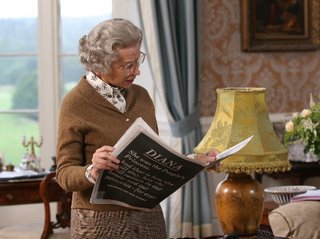 When the Honourable Diana Frances Spencer entered the world stage as the timid and lovely young bride of the infamously uptight and philandering heir presumptive to the British monarchy, she seemed to be living every little girls fantasy. Nabbing a rich man who would be too consumed with his own affairs, stately and carnally to give two shits about her own daily existence. For some gals, this would be a boon. Imagine, being able to shop all day long and be expected to lay down and close her eyes and think of England only twice once she had produced the heir and the spare.
When the Honourable Diana Frances Spencer entered the world stage as the timid and lovely young bride of the infamously uptight and philandering heir presumptive to the British monarchy, she seemed to be living every little girls fantasy. Nabbing a rich man who would be too consumed with his own affairs, stately and carnally to give two shits about her own daily existence. For some gals, this would be a boon. Imagine, being able to shop all day long and be expected to lay down and close her eyes and think of England only twice once she had produced the heir and the spare.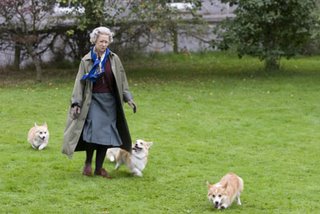 Having done her duty, we figured that the monarchy was saved yet again, and she could keep herself busy with her celebrity friendships and designer togs. Little did we know that the Princess Diana was a fool for love. She wanted a real marriage. Now anybody with even a passing knowledge of the Royal Houses of Europe knows that love and marriage are two distinct worlds to those nutty inbreeders. So, years later, now a glamorous divorcee with a real penchant to communicate with the people and a desire to do good, she turned into quite the international ambassador for several noble causes.
Having done her duty, we figured that the monarchy was saved yet again, and she could keep herself busy with her celebrity friendships and designer togs. Little did we know that the Princess Diana was a fool for love. She wanted a real marriage. Now anybody with even a passing knowledge of the Royal Houses of Europe knows that love and marriage are two distinct worlds to those nutty inbreeders. So, years later, now a glamorous divorcee with a real penchant to communicate with the people and a desire to do good, she turned into quite the international ambassador for several noble causes.
 All this would end on August 31, 1997 in a speeding Mercedes in our beloved Paris.
All this would end on August 31, 1997 in a speeding Mercedes in our beloved Paris.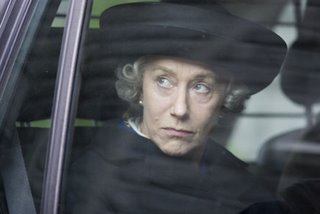 While the conspiracy theorists continue to argue the details of the accident that took her life, what transpired in the weeks following her untimely demise was a tabloid wet dream. The rigidity and formality of the centuries old house of Windsor came crumbling down around their enlarged ears when the public cried out for a display of mourning and respect for the fallen former HRH. Her majesty, the Queen denied the public their wishes. Barricading her family in their famed country retreat, Barmoral Castle, she managed to appear more aloof and indifferent than ever before.
While the conspiracy theorists continue to argue the details of the accident that took her life, what transpired in the weeks following her untimely demise was a tabloid wet dream. The rigidity and formality of the centuries old house of Windsor came crumbling down around their enlarged ears when the public cried out for a display of mourning and respect for the fallen former HRH. Her majesty, the Queen denied the public their wishes. Barricading her family in their famed country retreat, Barmoral Castle, she managed to appear more aloof and indifferent than ever before. The newly elected Prime Minister Tony Blair milked the cameras and the hearts and minds of the world at large with his seemingly heartfelt tribute to Diana. And still the royals would not appear. The political machinations, the entreaties, the twisting of bejeweled arms behind damask curtains held the world glued to the drama occurring behind castle walls. Ultimately, the public’s outcry would prevail and the Queen, her majesty did a remarkable thing.
The newly elected Prime Minister Tony Blair milked the cameras and the hearts and minds of the world at large with his seemingly heartfelt tribute to Diana. And still the royals would not appear. The political machinations, the entreaties, the twisting of bejeweled arms behind damask curtains held the world glued to the drama occurring behind castle walls. Ultimately, the public’s outcry would prevail and the Queen, her majesty did a remarkable thing. She acquiesced. She flew the flag above Buckingham Palace at half mast, (a breach of Royal etiquette for a banished member of their household), she led a return to London and made a very public display alongside her cryptkeeper husband, Prince Phillip and her mourning grandchildren, the heirs to Diana’s legacy amongst the throngs of well wishers mobbing the gates of the palace.
She acquiesced. She flew the flag above Buckingham Palace at half mast, (a breach of Royal etiquette for a banished member of their household), she led a return to London and made a very public display alongside her cryptkeeper husband, Prince Phillip and her mourning grandchildren, the heirs to Diana’s legacy amongst the throngs of well wishers mobbing the gates of the palace.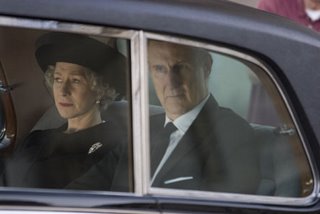 She made a very stilted, but perfectly orchestrated public address via satellite thanking the world for their massive display of grief and condolences throughout the days following Diana’s death. Everyone seemed to breath a sigh of relief and the public got its state funeral with all the trimmings.
She made a very stilted, but perfectly orchestrated public address via satellite thanking the world for their massive display of grief and condolences throughout the days following Diana’s death. Everyone seemed to breath a sigh of relief and the public got its state funeral with all the trimmings.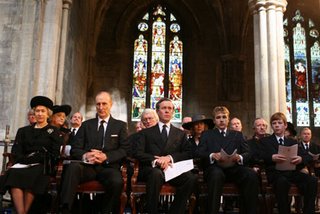 The only problem was, that in giving in to the public wishes and her Prime Minister’s entreaties, her Majesty had humbled herself in a manner that no British Monarch had since the days of King John.
The only problem was, that in giving in to the public wishes and her Prime Minister’s entreaties, her Majesty had humbled herself in a manner that no British Monarch had since the days of King John. Stephen Frears delivers a captivating film that manages to recreate the extraordinary drama that occurred without once resorting to tabloid fodder or over the top hysterics. But then again, he has always been a master of the slow burn and the richly layered storytelling. His best work: “My Beautiful Laundrette”, “Prick Up Your Ears”, “Dangerous Liaisons”, “The Grifters”, “The Snapper”, “High Fidelity” and “Dirty Pretty Things” are wonderful films that take the time to earn their emotional highlights. “The Queen” is no exception.
Stephen Frears delivers a captivating film that manages to recreate the extraordinary drama that occurred without once resorting to tabloid fodder or over the top hysterics. But then again, he has always been a master of the slow burn and the richly layered storytelling. His best work: “My Beautiful Laundrette”, “Prick Up Your Ears”, “Dangerous Liaisons”, “The Grifters”, “The Snapper”, “High Fidelity” and “Dirty Pretty Things” are wonderful films that take the time to earn their emotional highlights. “The Queen” is no exception.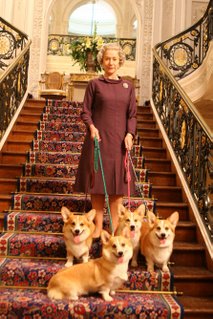 By focusing on the smaller moments that threatened to up heave a millennium old system of order, the film builds real dramatic tension from the contrasting ruling styles of Queen Elizabeth II and her Prime Minister Tony Blair. And with such wonderful actors as Helen Mirren and Michael Blair in the roles, the sparks are low key, but powerful nonetheless.
By focusing on the smaller moments that threatened to up heave a millennium old system of order, the film builds real dramatic tension from the contrasting ruling styles of Queen Elizabeth II and her Prime Minister Tony Blair. And with such wonderful actors as Helen Mirren and Michael Blair in the roles, the sparks are low key, but powerful nonetheless.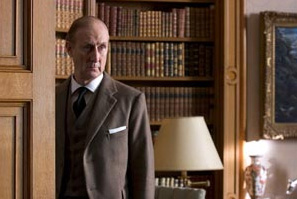 In the supporting roles, James Cromwell is particularly fine as the famously unpopular Prince Consort. His rigidity and bilious dislike for the legacy of Diana might secretly be shared by the Queen, but they certainly do not help in maintaining a sense of family at home.
In the supporting roles, James Cromwell is particularly fine as the famously unpopular Prince Consort. His rigidity and bilious dislike for the legacy of Diana might secretly be shared by the Queen, but they certainly do not help in maintaining a sense of family at home. Sylvia Sims manages to steal the few scenes she is in as the Queen Mother. This onetime sexpot . . . seriously, check her out above . . . is having a rollicking good time as the aged matriarch who subtly attempts to cool the frayed nerves and maintain decorum.
Sylvia Sims manages to steal the few scenes she is in as the Queen Mother. This onetime sexpot . . . seriously, check her out above . . . is having a rollicking good time as the aged matriarch who subtly attempts to cool the frayed nerves and maintain decorum.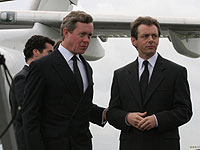 As Prince Charles, Alex Jennings is saddled with the most thankless role. For as in life, Charles isn’t very interesting at all. Especially in the context of the surrounding cast. He certainly isn’t bad, just not as robust a character or accomplished performer as the two leads.
As Prince Charles, Alex Jennings is saddled with the most thankless role. For as in life, Charles isn’t very interesting at all. Especially in the context of the surrounding cast. He certainly isn’t bad, just not as robust a character or accomplished performer as the two leads. The joy of watching solid filmmaking is a rare treasure nowadays. Best exemplified in one of the final scenes after the battle royale has subsided, the Prime Minister returns to Buckingham Palace to meet with the Queen. As he attempts to make small talk, the Queen gazes coolly upon him. The multitude of emotions that barely flicker across Dame Helen Mirren’s face as she attempts to maintain her composure is a moment of such great acting on display that it left us breathless. It is a purely cinematic moment that deserves mention, for being handled so beautifully.
The joy of watching solid filmmaking is a rare treasure nowadays. Best exemplified in one of the final scenes after the battle royale has subsided, the Prime Minister returns to Buckingham Palace to meet with the Queen. As he attempts to make small talk, the Queen gazes coolly upon him. The multitude of emotions that barely flicker across Dame Helen Mirren’s face as she attempts to maintain her composure is a moment of such great acting on display that it left us breathless. It is a purely cinematic moment that deserves mention, for being handled so beautifully.
 Dame Helen deserves any award that might come her way this year, and pound for sterling pound, Michael Sheen is to be applauded for not only maintaining his foothold in their scenes together but helping to make them shine.
Dame Helen deserves any award that might come her way this year, and pound for sterling pound, Michael Sheen is to be applauded for not only maintaining his foothold in their scenes together but helping to make them shine.
 “The Queen” is a wonderful film. One of the best of the year. Go now, and see it! We decree it. Bless you all!
“The Queen” is a wonderful film. One of the best of the year. Go now, and see it! We decree it. Bless you all!Directed by Stephen Frears
Written by Peter Morgan
Starring
Helen Mirren as HM Queen Elizabeth II
Michael Sheen as Tony Blair
James Cromwell as Prince Philip
Alex Jennings as Prince Charles
Sylvia Syms as HM The Queen Mother
Roger Allam as Robin Janvrin
Helen McCrory as Cherie Blair
Mark Bazeley as Alastair Campbell
Cinematography by Affonso Beato
Film Editing by Lucia Zucchetti
Original Music by Alexandre Desplat
Production Design by Alan MacDonald
Art Direction by Matthew Broderick
Set Decoration by Tina Jones
Costume Design by Consolata Boyle

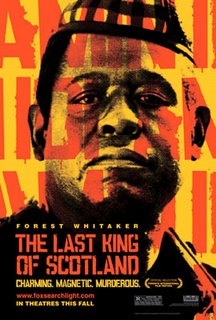 Sometimes, very rarely, we are woken from our celluloid induced somnambulism by the presence of a well made piece of cinema that reinvigorates our belief in this fine medium. Over the past few months we have been dying slowly, little by little by continuous streams of wearisome and amateurish independent dramas concerning
Sometimes, very rarely, we are woken from our celluloid induced somnambulism by the presence of a well made piece of cinema that reinvigorates our belief in this fine medium. Over the past few months we have been dying slowly, little by little by continuous streams of wearisome and amateurish independent dramas concerning  Thankfully, the fall is with us and the studios are rushing to book their award worthy hopefuls into the stacked movie houses across the land.
Thankfully, the fall is with us and the studios are rushing to book their award worthy hopefuls into the stacked movie houses across the land. Kevin Macdonald’s adaptation of Giles Foden fine fictionalized version of Idi Amin’s brutal reign of terror as the onetime leader of Uganda, lands in the theatre just in time to entertain movie goers with a fine adult drama that pulls no punches, features two fantastic performances and will leave you feeling more than satisfied you ventured out of your dwellings to enjoy “The Last King of Scotland”.
Kevin Macdonald’s adaptation of Giles Foden fine fictionalized version of Idi Amin’s brutal reign of terror as the onetime leader of Uganda, lands in the theatre just in time to entertain movie goers with a fine adult drama that pulls no punches, features two fantastic performances and will leave you feeling more than satisfied you ventured out of your dwellings to enjoy “The Last King of Scotland”. As the infamous dictator general,
As the infamous dictator general,  As the second lead, one Nicholas Garrigan, a young Scottish doctor out to visit Uganda at its most critical time in history,
As the second lead, one Nicholas Garrigan, a young Scottish doctor out to visit Uganda at its most critical time in history,  And in the lesser but crucial role of a fellow volunteer, Sarah Merrit who attempts to warn Nicholas of the complex machinations at play in the mad mind of General Amin,
And in the lesser but crucial role of a fellow volunteer, Sarah Merrit who attempts to warn Nicholas of the complex machinations at play in the mad mind of General Amin, 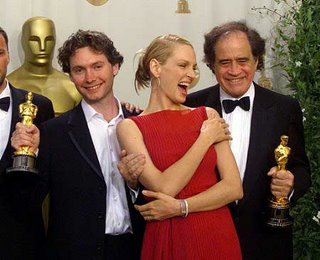 When we first noticed director Kevin Macdonald’s name it was for his brilliant Oscar winning documentary “
When we first noticed director Kevin Macdonald’s name it was for his brilliant Oscar winning documentary “ Now, with his foray into fictional storytelling his talents are used to beautiful effect. His use of the camera, cinematography, editing and carefully chosen cast is commendable. His ability to paint a harrowing tale of lost innocence, temptation, political intrigue amidst the skeleton of the turgid life of Idi Amin is nothing short of entrancing.
Now, with his foray into fictional storytelling his talents are used to beautiful effect. His use of the camera, cinematography, editing and carefully chosen cast is commendable. His ability to paint a harrowing tale of lost innocence, temptation, political intrigue amidst the skeleton of the turgid life of Idi Amin is nothing short of entrancing.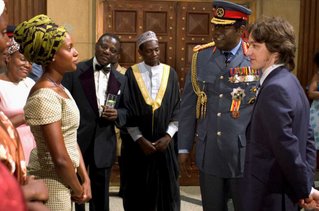 What makes this film a truly solid piece of work is the economy Macdonald employs in telling his complex tale. We understand immediately the character of Nicholas Garrigan. An idealistic young man whose inability to look further than the surface of his own desires is visualized in the childish act of deciding his future by spinning a globe while closing his eyes. When his finger lands on Uganda (after an abandoned first choice, natch) he is off and running.
What makes this film a truly solid piece of work is the economy Macdonald employs in telling his complex tale. We understand immediately the character of Nicholas Garrigan. An idealistic young man whose inability to look further than the surface of his own desires is visualized in the childish act of deciding his future by spinning a globe while closing his eyes. When his finger lands on Uganda (after an abandoned first choice, natch) he is off and running.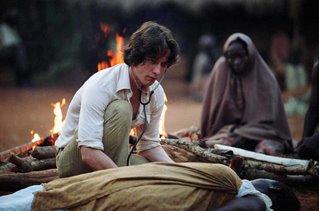 Once there, his heart is in the right place attempting to help the needy, but his head cannot fathom the shifting landscape around him. When he encounters the powerhouse Amin preaching to the hysterical throng, he is swept away with the enthusiasm that can only be called pure by the very young or the very stupid. He is unfortunately a combination of both at this point in his travels.
Once there, his heart is in the right place attempting to help the needy, but his head cannot fathom the shifting landscape around him. When he encounters the powerhouse Amin preaching to the hysterical throng, he is swept away with the enthusiasm that can only be called pure by the very young or the very stupid. He is unfortunately a combination of both at this point in his travels.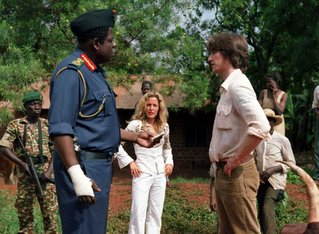 After a dramatic and traumatic experience aiding the wounded Amin after a roadside accident, Amin takes note of the young doctor’s quick thinking and ballsy attitude. When Amin calls upon him to become his personal doctor, he undertakes the risky move in the vain hopes of being part of a brave new Uganda. Being that Amin was indeed a madman only brings pain and suffering on a scale that Nicholas could never have hoped to comprehend at the beginning of his journey.
After a dramatic and traumatic experience aiding the wounded Amin after a roadside accident, Amin takes note of the young doctor’s quick thinking and ballsy attitude. When Amin calls upon him to become his personal doctor, he undertakes the risky move in the vain hopes of being part of a brave new Uganda. Being that Amin was indeed a madman only brings pain and suffering on a scale that Nicholas could never have hoped to comprehend at the beginning of his journey. Amin’s
Amin’s  One of the great moments in this wonderful film is when Nicholas is desperately trying to escape his newfound prison, only to catch a fleeting glimpse of his onetime mentor, the lovely Sarah Merrit as she is fleeing aboard a crowded bus of refugees. The look of terror, the outreach of sympathy and the lightning fast exchange of wordless farewells speaks volumes. It is a great cinematic moment made glorious by a director who trusts the power of images and the strength of a well crafted screenplay.
One of the great moments in this wonderful film is when Nicholas is desperately trying to escape his newfound prison, only to catch a fleeting glimpse of his onetime mentor, the lovely Sarah Merrit as she is fleeing aboard a crowded bus of refugees. The look of terror, the outreach of sympathy and the lightning fast exchange of wordless farewells speaks volumes. It is a great cinematic moment made glorious by a director who trusts the power of images and the strength of a well crafted screenplay. The nail biting finale set against the famed hostage crisis at the
The nail biting finale set against the famed hostage crisis at the 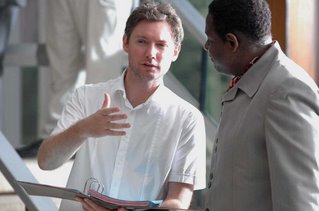 It is to the credit of director Macdonald and the towering performances by Forest Whitaker and James McAvoy that we care so very much for the final outcome. For while we understand that Amin’s time has come to an end, we are held spellbound awaiting the fate of the once innocent young doctor and the ravaged nation he has so carelessly stumbled upon. A truly wonderful and powerful film, and one we hope you will venture out to experience for yourselves. Bless you all!
It is to the credit of director Macdonald and the towering performances by Forest Whitaker and James McAvoy that we care so very much for the final outcome. For while we understand that Amin’s time has come to an end, we are held spellbound awaiting the fate of the once innocent young doctor and the ravaged nation he has so carelessly stumbled upon. A truly wonderful and powerful film, and one we hope you will venture out to experience for yourselves. Bless you all!
 Oh, the magic that two fine actors can wield when parlaying roles in a slightly less than grand film. Case in point, the wonderful star turns by Gael García Bernal and
Oh, the magic that two fine actors can wield when parlaying roles in a slightly less than grand film. Case in point, the wonderful star turns by Gael García Bernal and  We meet a young man named Stéphane who to label a dreamer would be far too painful an understatement. Here is a character whose waking life is eternally spotted with rococo fantasies. He returns to Paris to accept a job offer his mother has helped to secure. It is an outwardly miserable experience setting type for an unimaginative calendar in an oppressive office. When Stéphane attempts to speak with the head of the small company about his idea for a calendar . . . well, let’s just leave that for the viewer to discover for themselves. For it is a priceless moment.
We meet a young man named Stéphane who to label a dreamer would be far too painful an understatement. Here is a character whose waking life is eternally spotted with rococo fantasies. He returns to Paris to accept a job offer his mother has helped to secure. It is an outwardly miserable experience setting type for an unimaginative calendar in an oppressive office. When Stéphane attempts to speak with the head of the small company about his idea for a calendar . . . well, let’s just leave that for the viewer to discover for themselves. For it is a priceless moment.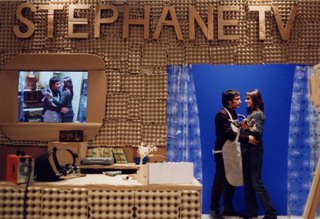 And you, dear viewer should venture forth and see “The Science of Sleep”. For while we had many questions and concerns about the finished product, the charisma and excitement that two strong actors can generate together more than compensate for the films lack of clarity. Now, let’s be clear ourselves. We do not question the heavy use of dream imagery, or the intentionally deceptive moments where we are taken down one road only to have the cobblestones plucked gingerly away one by one.
And you, dear viewer should venture forth and see “The Science of Sleep”. For while we had many questions and concerns about the finished product, the charisma and excitement that two strong actors can generate together more than compensate for the films lack of clarity. Now, let’s be clear ourselves. We do not question the heavy use of dream imagery, or the intentionally deceptive moments where we are taken down one road only to have the cobblestones plucked gingerly away one by one. Our issue is one with the film’s overall tone. We thought Gondry nailed it perfectly with “Eternal Sunshine of the Spotless Mind”. A terrific balancing act between comedy, drama, romance and the illusion that somehow all three might be exclusive. Here, the dreams of Stéphane threaten at times to turn into nightmarish visions of this charming young man that we fear might be his undoing.
Our issue is one with the film’s overall tone. We thought Gondry nailed it perfectly with “Eternal Sunshine of the Spotless Mind”. A terrific balancing act between comedy, drama, romance and the illusion that somehow all three might be exclusive. Here, the dreams of Stéphane threaten at times to turn into nightmarish visions of this charming young man that we fear might be his undoing.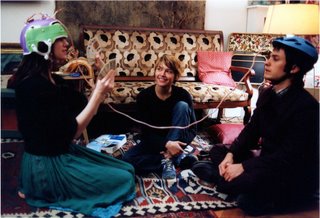 For when he moves into his old flat, he meets a new neighbor across the hall – two new neighbors. Two charming young girls by the names of Zoé and Stéphanie. While Zoé may be the more brazen of the two, it is Stéphanie that Stéphane falls madly in love with. And all because he realizes that she too has moments of dreamlike clarity wherein they can meet and play.
For when he moves into his old flat, he meets a new neighbor across the hall – two new neighbors. Two charming young girls by the names of Zoé and Stéphanie. While Zoé may be the more brazen of the two, it is Stéphanie that Stéphane falls madly in love with. And all because he realizes that she too has moments of dreamlike clarity wherein they can meet and play.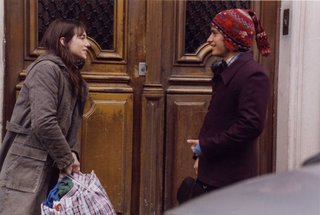 And with such a young and gorgeous young actress as Charlotte Gainsbourg in the role of Stéphanie, it would seem foolish not to fall in love with her. Unless of course the male lead where played by the even more attractive Gael García Bernal. If their physical beauty and effortless charm where all they had going for them, well then they might as well be in a softcore Playboy Channel teleflick.
And with such a young and gorgeous young actress as Charlotte Gainsbourg in the role of Stéphanie, it would seem foolish not to fall in love with her. Unless of course the male lead where played by the even more attractive Gael García Bernal. If their physical beauty and effortless charm where all they had going for them, well then they might as well be in a softcore Playboy Channel teleflick. 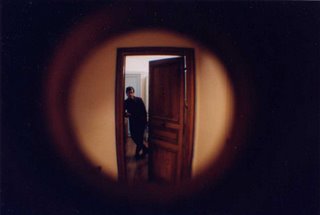 The triumph of this film is the tender and complex relationship that slowly begins to build between the dreamer and the romantic. Which are two very separate ideals. A relationship that gets off to so many hilarious aborted beginnings, that we beg of you to go and witness them for yourselves. It is a wonderful sense of comedy that grows intuitively from the characters and their situations and is not thrust upon them for sight gags and slapstick.
The triumph of this film is the tender and complex relationship that slowly begins to build between the dreamer and the romantic. Which are two very separate ideals. A relationship that gets off to so many hilarious aborted beginnings, that we beg of you to go and witness them for yourselves. It is a wonderful sense of comedy that grows intuitively from the characters and their situations and is not thrust upon them for sight gags and slapstick. Unfortunately, the slapstick is left to the supporting cast. It isn’t that they are without talent; it is just that Gondry seems to be using them as tools instead of characters. While we can laugh and be charmed at the inane mistakes Stéphane keeps making in the name of romance, the knockabout farce of his workplace begins to grate on the nerves after one scene.
Unfortunately, the slapstick is left to the supporting cast. It isn’t that they are without talent; it is just that Gondry seems to be using them as tools instead of characters. While we can laugh and be charmed at the inane mistakes Stéphane keeps making in the name of romance, the knockabout farce of his workplace begins to grate on the nerves after one scene. Perhaps it has more to do with the lovely scenes set within Stéphane’s dream landscape, since their pull is so strong. The whirling bits of animation which take their inspiration from mundane everyday objects are inspiring. As inspiring as the central casting. But if the dream imagery and blooming romance between Gael and Charlotte works beautifully, it is the realist side of Michel Gondry that provides one of the most striking scenes.
Perhaps it has more to do with the lovely scenes set within Stéphane’s dream landscape, since their pull is so strong. The whirling bits of animation which take their inspiration from mundane everyday objects are inspiring. As inspiring as the central casting. But if the dream imagery and blooming romance between Gael and Charlotte works beautifully, it is the realist side of Michel Gondry that provides one of the most striking scenes.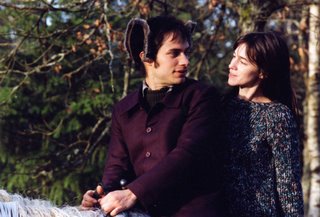 While we enjoyed the ride, we could hardly have anticipated the ending of this film. We will not spoil it for you, for we believe it is well worth seeing for yourselves. And we suppose that any fan of Gondry’s would not be surprised by his caustic wit and obtuse sense of a romantic ideal. Suffice to say, the film ends on a bittersweet note that managed for us at least to be faithful to his dreams and blisteringly “real” enough to make the audience yearn for a happy ending.
While we enjoyed the ride, we could hardly have anticipated the ending of this film. We will not spoil it for you, for we believe it is well worth seeing for yourselves. And we suppose that any fan of Gondry’s would not be surprised by his caustic wit and obtuse sense of a romantic ideal. Suffice to say, the film ends on a bittersweet note that managed for us at least to be faithful to his dreams and blisteringly “real” enough to make the audience yearn for a happy ending.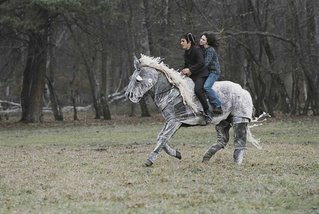 Whether or not you receive a true happy ending for this starry eyed duo remains securely in the eye of the beholder. So go forth, gentle readers and partake of the stuff that dreams are made of. We’re glad we did. Bless you all!
Whether or not you receive a true happy ending for this starry eyed duo remains securely in the eye of the beholder. So go forth, gentle readers and partake of the stuff that dreams are made of. We’re glad we did. Bless you all! The Black Dahlia 2006
The Black Dahlia 2006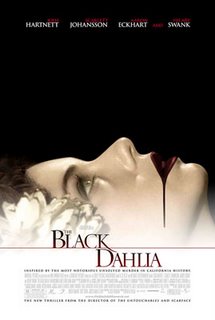 “The Black Dahlia” is the latest cinematic take on what is perhaps Los Angeles most
“The Black Dahlia” is the latest cinematic take on what is perhaps Los Angeles most  There were so many wonderful things to enjoy while watching “The Black Dahlia”, that we sound positively ungrateful with the final product. Well, we’re sorry Brian. Honestly. We have adored your work in the past: “
There were so many wonderful things to enjoy while watching “The Black Dahlia”, that we sound positively ungrateful with the final product. Well, we’re sorry Brian. Honestly. We have adored your work in the past: “ The novel by James Ellroy was a macabre, entertaining piece of crime fiction that managed to pay homage to the brief, sad life of Elizabeth Short while incorporating some very fascinating tidbits about the corrupt system that ran throughout the film industry, police force and public offices of mid twentieth century Los Angeles. The notion that Betty Short was murdered as a sort of sacrificial lamb to the injustices of Hollywood society played out richly in a tapestry that included vice and drama all along the labyrinthine way.
The novel by James Ellroy was a macabre, entertaining piece of crime fiction that managed to pay homage to the brief, sad life of Elizabeth Short while incorporating some very fascinating tidbits about the corrupt system that ran throughout the film industry, police force and public offices of mid twentieth century Los Angeles. The notion that Betty Short was murdered as a sort of sacrificial lamb to the injustices of Hollywood society played out richly in a tapestry that included vice and drama all along the labyrinthine way.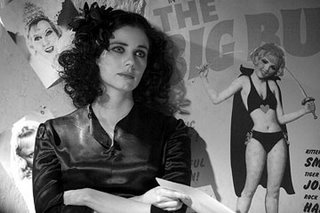 Perhaps it was too much for one film to handle. The novel would play beautifully as an extended mini-series that allowed the director and writer to expand on those ideas. Here, they are truncated into a murder mystery whodunit, that doesn’t allow enough time to soak in the various storylines and can’t quite break the code in allowing them to freely flow together. When we learn who is responsible (in this fictional piece, the jury is still out on the real murder
Perhaps it was too much for one film to handle. The novel would play beautifully as an extended mini-series that allowed the director and writer to expand on those ideas. Here, they are truncated into a murder mystery whodunit, that doesn’t allow enough time to soak in the various storylines and can’t quite break the code in allowing them to freely flow together. When we learn who is responsible (in this fictional piece, the jury is still out on the real murder 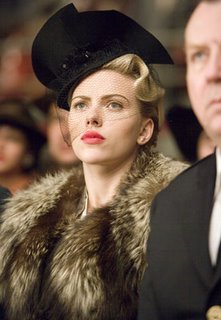 The good news is the look and feel of the film. Starting out with that champion Oscar winning cinematographer, Vilmos Zsigmond who crafted some of the most ravishing films of the 1970s: “
The good news is the look and feel of the film. Starting out with that champion Oscar winning cinematographer, Vilmos Zsigmond who crafted some of the most ravishing films of the 1970s: “ To fill out those finely crafted costumes and bathe in the flattering light, De Palma has cast a very good looking and talented team of players. Josh Hartnett and Aaron Eckhart go square jaw to square jaw (literally) as pugilists turned police officers who enter into a twisted symbiotic relationship that includes Eckhart’s live in flame, the perfectly cast Scarlett Johansson. This trio anchor the story quite well, despite the varied degrees of acting talents involved. We’re looking at you, Josh – you may be very fuckable, but nobody has ever shortlisted you for thespian gifts.
To fill out those finely crafted costumes and bathe in the flattering light, De Palma has cast a very good looking and talented team of players. Josh Hartnett and Aaron Eckhart go square jaw to square jaw (literally) as pugilists turned police officers who enter into a twisted symbiotic relationship that includes Eckhart’s live in flame, the perfectly cast Scarlett Johansson. This trio anchor the story quite well, despite the varied degrees of acting talents involved. We’re looking at you, Josh – you may be very fuckable, but nobody has ever shortlisted you for thespian gifts. As Officer Dwight “Bucky” Bleichert, Josh Hartnett has finally found a role that doesn’t embarrass his acceptable but limited range as an actor. He has always been fairly decent at glowering and foisting his mitts when necessary, and here the part calls for little more. Perhaps an exuberant grunt or lustful stare, which thankfully Josh is capable of. Enjoy the praise, while you can, Joshy.
As Officer Dwight “Bucky” Bleichert, Josh Hartnett has finally found a role that doesn’t embarrass his acceptable but limited range as an actor. He has always been fairly decent at glowering and foisting his mitts when necessary, and here the part calls for little more. Perhaps an exuberant grunt or lustful stare, which thankfully Josh is capable of. Enjoy the praise, while you can, Joshy.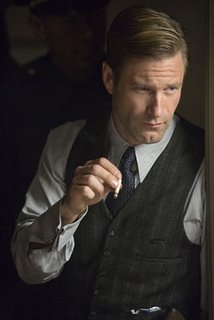 Aaron Eckhart has proven his acting skills in many previous films, so how strange is it that here he is outshone by Josh Hartnett? Well, to a point. As Sergeant Leland “Lee” Blanchard, we think either Aaron was sleepwalking through the role or his best scenes are somewhere on the cutting room floor. Possibly a mix of both. He is never God awful, or embarrassing – merely not half as interesting a presence as other performers. To wit, the distaff side of this grisly little thriller.
Aaron Eckhart has proven his acting skills in many previous films, so how strange is it that here he is outshone by Josh Hartnett? Well, to a point. As Sergeant Leland “Lee” Blanchard, we think either Aaron was sleepwalking through the role or his best scenes are somewhere on the cutting room floor. Possibly a mix of both. He is never God awful, or embarrassing – merely not half as interesting a presence as other performers. To wit, the distaff side of this grisly little thriller.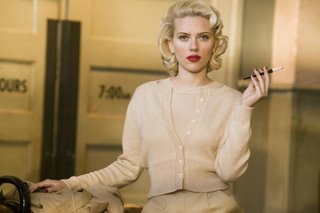 Scarlett Johansson has always been a striking figure, if not the most accomplished actress. When the role is a perfect match, she shines. Such as her wonderful turns in “Ghost World” or last year's “
Scarlett Johansson has always been a striking figure, if not the most accomplished actress. When the role is a perfect match, she shines. Such as her wonderful turns in “Ghost World” or last year's “ But Kay Lake is certainly not the only mystery lady around town, for into Bucky’s investigation of the Betty Short murder walks a willowy stunner named Madeleine Linscott. As Madeleine, two time Oscar winning Best Actress Hilary Swank delivers the home run performance. Her Madeleine may have sprung from watching too many classic Film Noirs, but she is the only actor brave enough to attempt to match their heightened tone and succeed. It may not be the performance of the year, since the material is so uneven, but Hilary gets major points for attempting the risk. Her Madeleine is a man and woman eating cobra that brings Bucky to his knees while whispering promises of secrets revealed that just might crack this headline charting mystery.
But Kay Lake is certainly not the only mystery lady around town, for into Bucky’s investigation of the Betty Short murder walks a willowy stunner named Madeleine Linscott. As Madeleine, two time Oscar winning Best Actress Hilary Swank delivers the home run performance. Her Madeleine may have sprung from watching too many classic Film Noirs, but she is the only actor brave enough to attempt to match their heightened tone and succeed. It may not be the performance of the year, since the material is so uneven, but Hilary gets major points for attempting the risk. Her Madeleine is a man and woman eating cobra that brings Bucky to his knees while whispering promises of secrets revealed that just might crack this headline charting mystery. And this is where we should have gotten off the speeding trolley car and demanded our money back. For once Madeleine enters the picture, the tone is thrown out the window in pursuit of a cinematic path to closure that desperately eludes De Palma. The flashbacks revealing a pathetically yearning Betty Short resorting to a life of vice should have acted as a wonderful foil for the investigation into her death, but they seem to point up the bigger problems in “The Black Dahlia”. The storylines of Bucky, Lee, Kay and Madeleine are too rich and interesting in their own intertwined passions to be diluted by the ghost of a girl that Hollywood quickly devoured. We care more for the four lead actors than the young woman who in reality suffered through one of the most senseless crimes in LaLaLand’s history.
And this is where we should have gotten off the speeding trolley car and demanded our money back. For once Madeleine enters the picture, the tone is thrown out the window in pursuit of a cinematic path to closure that desperately eludes De Palma. The flashbacks revealing a pathetically yearning Betty Short resorting to a life of vice should have acted as a wonderful foil for the investigation into her death, but they seem to point up the bigger problems in “The Black Dahlia”. The storylines of Bucky, Lee, Kay and Madeleine are too rich and interesting in their own intertwined passions to be diluted by the ghost of a girl that Hollywood quickly devoured. We care more for the four lead actors than the young woman who in reality suffered through one of the most senseless crimes in LaLaLand’s history.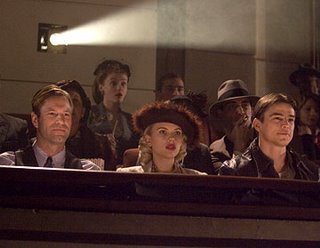 Her story becomes less of a metaphor and more of a nuisance that completely unravels by the films finale which is too out of left field to be acceptable even in the heavy lidded world of Film Noir. Which is a shame indeed, for we enjoyed many aspects of “The Black Dahlia”, from the sumptuous look of the piece to the typically ornate set pieces that have made De Palma a respected director. At least we left the theatre feeling the genuine effort involved even if we didn’t care for the particulars. Not to worry, Brian, we have faith in your talents and will be the first ones in line for your next offering. Bless you all!
Her story becomes less of a metaphor and more of a nuisance that completely unravels by the films finale which is too out of left field to be acceptable even in the heavy lidded world of Film Noir. Which is a shame indeed, for we enjoyed many aspects of “The Black Dahlia”, from the sumptuous look of the piece to the typically ornate set pieces that have made De Palma a respected director. At least we left the theatre feeling the genuine effort involved even if we didn’t care for the particulars. Not to worry, Brian, we have faith in your talents and will be the first ones in line for your next offering. Bless you all!
